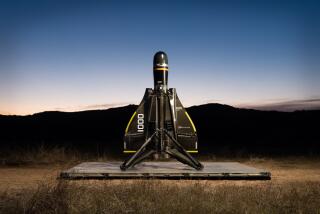Garbage-Can ‘Missiles’ Con Enemy Pilots : Launchers of a Dummy Warhead Business
- Share via
1) Who says they’re such great garbage cans?
2) Their language seems just a tad too perfect.
3) Are we sure DOD actually has a contract out?
After a while, you get tired of making garbage cans.
Granted, you make one of the best waste bins in the U.S. of A. Sooner or later, though, you will meet a stranger across a crowded room, and he or she is going to ask: “What do you do?”
“I used to look ‘em right in the eye,” says Randy Gardiner, “and say, ‘I’m in garbage cans.’ After a while, though, I just finessed it.”
“Me,” says Brian Gardiner, Randy’s brother and business partner, “I’d just look conspiratorial, like the guy in ‘The Graduate,’ and kind of half-whisper, ‘Plastics.’ ”
“Now,” Randy says, “we hitch up our belts and say, ‘We’re defense contractors.’ ”
Randy and Brian Gardiner, 32 and 30 respectively, stand in the slightly sinister shadow of the 24-foot “surface-to-air missile” (SAM) they’ve erected outside RMB Products in Simi Valley and trace their firm’s recent metamorphosis. They’re only half-kidding.
“We have been doing some defense subcontracting,” says Brian: “ammunition casings, aircraft ducts, that sort of thing.”
Nevertheless, he confesses, “The garbage can is still our bread and butter. I wish you wouldn’t keep calling it that, though. How about ‘trash can?’ Would you buy ‘waste receptacle?’ ”
‘Cans With Pretensions’
“Whatever,” says Randy, “that’s what this is, this SAM thing. Five garbage cans with pretensions, stacked and joined. Add fins, a nose cone, a camouflage paint job, and what you have is. . . .”
What you have is a “surface-to-air missile” that looks real enough to con a low-flying fighter pilot--which may or may not swell the breasts of the good citizens of Simi Valley.
“That’s the whole point: fakery,” says Ray Sinwell, RMB contracts manager and resident tongue-in-cheek.
The Department of Defense, Sinwell said, is forever dreaming up new products, some fanciful, some fatuous, others actually verging on the practical.
“This one,” Sinwell says, “is one of their better ideas.” The Air Force’s “Draft Request of Proposal” calls the project for which they are soliciting bids, “Camouflage, Concealment and Deception Integration.”
What the Air Force envisions is a whole clowder of clawless missiles spaced around, say, an airport and mixed in with the authentic article. Nobody knows where the dummies would be deployed, or which of the SAMs would be the real ones; the Air Force, naturally, isn’t saying.
Confounding the whole scenario, says Sinwell, would be “smoky SAMs,” semi-dummy missiles that leave a smoke trail, then flash. “The pilot goes, ‘Hoo boy, somebody’s shooting at me! I’d better shoot back.’ He’s going to look for something to attack,” he said.
“Yeah,” says Brian, “and think of the savings to the defense budget! SAMs, the real ones, cost what? Half a million? Better the pilot should be shooting at a $3,000 stack of, uh, waste receptacles.”
RMB, a sophisticated plastics-molding firm despite its trashy reputation, set about constructing a couple of sham SAMs, partly to see what they could come up with, partly with an eye toward a serious bid for the Air Force business, and partly--”Well, basically, we were just bored,” Brian says. “Once we had the first SAM made, we kind of liked it, so we put it up outside the plant. Sort of a showroom model.”
Would he sell it?
“Sure. I guess.”
How much?
“It’s listed for $4,800.”
Isn’t that a little steep?
“It’s not so much the material,” Sinwell says, “it’s the technology. This is truly low-tech stuff. That’s no stack of garbage cans; there’s inert guidance in there. Not inertial guidance. Inert.”
Still, that’s nearly the price of a Toyota.
“OK, sure,” says Brian, “but everybody has a Toyota. . . .”
Randy and Brian Gardiner work hard at their business, tinkering, experimenting, pumping Research and Development into the company founded in 1946 by their father, Bill. Their industrial receptacles--not those dent-prone Wednesday-night street specials--have a deserved reputation for strength, durability, even snazzy, if functional, good looks. It is labor, however, tempered with wit.
To catch the eye of the prime contractors--and anyone else who just might be in the market for a hollow anti-aircraft missile--Sinwell churned out a brochure for the new RMB subsidiary known as SAMs R Us.
Advertising an eight-foot polyethylene missile for $1,650, the release declares: “Budget-conscious military establishments desiring to assume a high-level air-defense posture will find the missile very cost-effective.”
“Future weapons,” depending on demand, would include “Son of a Hawk,” a “Stingerette” and “a simulated, floating anti-ship munition” called the “Forever B. Mine.”
Money Talks
Back to the authentic fake missiles, though: Would RMB actually sell them to the general public?
“You got a check,” Sinwell says, “you can put it in your car.”
“Buy 100 of ‘em,” says Brian, “and we’ll give you a deal.”
The offer is tempting, but just what would one do with a SAM?
“Free-standing backyard sculpture,” says Brian, “depending, of course, on how you get along with your neighbors.”
Brian: “A four-story outhouse?”
Sinwell: “How about a nice mine for the pool?”
“Dad (Bill Gardiner) was a real entrepreneur,” says Brian with pride. “After four years in the Philippines as a POW, he came back and, starting from nothing, made the world’s first plastic garbage can.”
“I started out to be an orthodontist,” admits Randy, now RMB president, “but I drifted into the family business. When you grow up among garbage cans. . . .”
“Believe it or not, it’s fascinating,” says vice president Brian, “especially new products. Besides the serious stuff, we’ve made hulls for model boats, custom items. . . . Once we filled an order for 100 potty seats for cats, to toilet-train them. Hey, it’s supply and demand. All we ask is that they pay their bills.”
Between the prosaic garbage can and the exotic missile, though, is there anything the brothers have an absolutely burning desire to make?
“Sure,” says Randy. “Money.”
More to Read
Sign up for Essential California
The most important California stories and recommendations in your inbox every morning.
You may occasionally receive promotional content from the Los Angeles Times.










